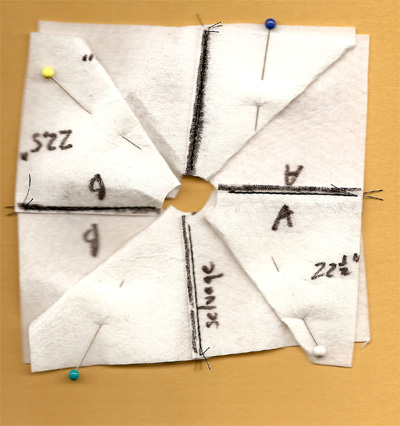- Prepare 4 top pieces, each 44" long and 22.5 inches deep. I recommend that you have one long end of each piece on the selvage. This will not only eliminate the need to finish that seam, but it will identify the edges that will be sewn together later on.
- Fold the pieces in half to find the center of the long selvage edge and iron the fold. (This is now a handy reference mark for construction).
- Cut a hole for the waist at the center of the long selvage edge. Make it large enough to get it over your hips or bust easily. Since circumference = pi * diameter, and pi is a bit more than 3, I simply say "The total diameter of waist circles = 1/3 the hip measurement." If we were making a circle skirt, we'd need a circle with a diameter of 12" for the average hip (34 - 38 inches). In this case, we are making the equivalent of a 2-circle skirt so the diameter of the circle is six inches. Make it easy on yourself and create a cardboard circle with the correct diameter, fold it in half, and use it as a pattern for the waist opening, as illustrated.



You should have eight corners in this skirt now, rounded or not.

- Create your ruffle strips. I recommend a 2x gather (ruffle twice as long as the edge it is being applied to) or slightly less (1.75x). You have eight edges of 45" each on this skirt (total 360 inches) so you'll need 720 inches (20 yards) of ruffle, more or less.
- Fast way for 52" fabric: Rip 24"-wide strips from 12 yards of 52" fabric, with a selvage down one long edge of each ruffle strip. (This will leave a long strip several inches wide from the middle of the yardage for other projects, or for the waistband casing.)
- Fast way for 45" fabric and normal-sized woman: 22.5" wide strips should work fine, so go ahead and rip as per above.
- Fast way for 45" fabric and tall woman: rip 16 pieces of the width you need, selvage to selvage.
- Gather the strips (along the selvage edge, if you followed ). I like to be able to control the gathers closely (for a better look) so I will run two or three basting seams by machine along the edges and then pull them to fit. Others use one basting seam, or they zig zag over a string and pull it up... whatever you prefer.
- Apply the gathered ruffle. If you have trouble controlling this process, then lay the blankety-blank skirt on a large flat surface and hand-baste the ruffle to the skirt before machine sewing them together. Sometimes hand basting takes less time (and is certainly less stressful!) than dealing with hundreds of pins and ornery slippery skirt pieces at the sewing machine.
- Apply the waistband casing (green mark around waist in diagram). Unless you made this skirt out of spider web, you'll need a 1.5" (or more) wide elastic to hold it up, which means a 4.5-inch wide casing piece which is as long as your waist opening circumference. Run a reasonable amount of elastic through the casing and fasten loosely with a pin. Adding the casing now means that the skirt will not slide out of the skirt hanger because of its weight during the next step. It also leaves you 100-percent-ready for a skirt fitting.
